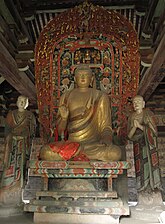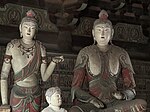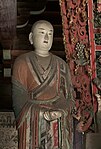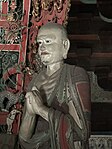Zhenguo Temple
37°17′08″N 112°16′15″E / 37.28556°N 112.27083°E
| Zhenguo Temple | |
|---|---|
Northern Han Dynasty |
| Zhenguo Temple | ||
|---|---|---|
Tâi-lô | Tìn-kok sī | |
Zhenguo Temple (
History
The history of the temple begins in 963, when it was recorded that Ten-Thousand Buddha Hall (Wànfó diàn 万佛殿) was built. The date is written on a beam in the hall, and is also the date given by a local history of
Layout
The temple contains two main halls and a gate, with two courtyards in between the three buildings. There is a wall surrounding the entire complex. The temple opens to the south, with the Tianwang Hall (天王殿) acting as the temple's gate.
Ten-Thousand Buddha Hall

The most important hall in the temple is Ten-Thousand Buddha Hall (Wànfó diàn 万佛殿), one of China's oldest wooden buildings. It is a three-bay single-eaves hip and gabled hall that is nearly square in shape, measures 11.6 by 10.8 meters, and is 8.8 m high.[7] Despite the building's small size, and features that would identify it as a regular hall (such as pillars that have been implanted directly into the floor instead of on a stone pedestal), the structure is quite complex. There are doors at the front and back of the hall. In addition, the front of the hall has two windows on either side of the door. There are twelve pillars supporting the structure.[5] The corner and column-top brackets holding up the roof are of the 7th degree, one of the most complex and large types according to Yingzao Fashi. These bracket sets are nearly 2.5 meters high – 70% the height of the columns. Inter-columnar brackets that occur between every two pillars are of the 5th degree. The hall has no ceiling, and the upper and lower set of rafters are exposed.[8] Nancy Steinhardt speculates that the complex brackets on what would have been a humble structure were an attempt by the Northern Han rulers to build a magnificent structure with limited resources.[9]
The hall contains eleven sculptures from the Northern Han period. These are the only Chinese sculptures from the period that survive from outside the
-
Tianwang Hall
-
Tianwang Hall
-
Wanfo Hall
-
Statues inside the Wanfo Hall
Image Gallery of Wanfo(Ten thousand Buddha) Hall Statues
Notes
- ^ a b Steinhardt (1997), 77.
- ^ Steinhardt (2002), 117.
- ^ Zhao (2007), 94.
- ^ "Pingyao Ancient City Evaluation" (PDF). UNESCO. 1996. Retrieved 2009-10-13.
- ^ a b c Steinhardt (1997), 78.
- ^ Miller (2000), 83.
- ^ Miller (2000), 83-84.
- ^ Steinhardt (1997), 79.
- ^ Steinhardt (1997), 80.
- ^ Howard (2006), 375.
References
- Howard, Angela Falco, et al. Chinese Sculpture. New Haven: ISBN 0-300-10065-5
- Miller, Tracy. "Constructing Religion: Song Dynasty Architecture and the Jinci Temple Complex." Diss. University of Pennsylvania, 2000.
- Steinhardt, Nancy Shatzman. Liao Architecture. Honolulu: University of Hawaii, 1997. ISBN 0-8248-1843-1
- Steinhardt, Nancy Shatzman ed. Chinese Architecture. New Haven: Yale University, 2002. ISBN 978-0-300-09559-3
- Zhao Yu, (in Chinese) ed. Shanxi. Beijing: Chinese Travel Press, 2007. ISBN 978-7-5032-3001-1
External links















